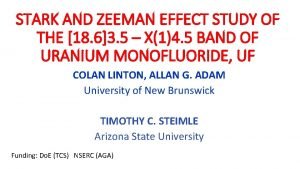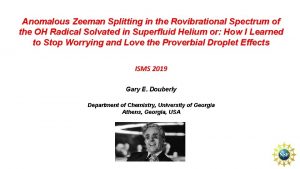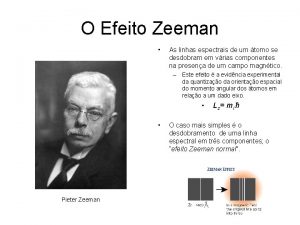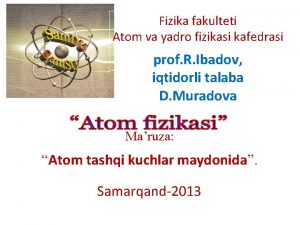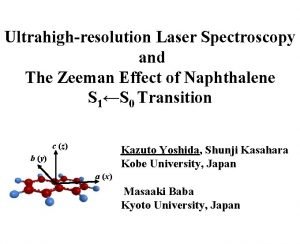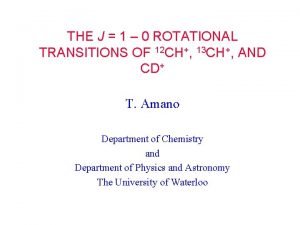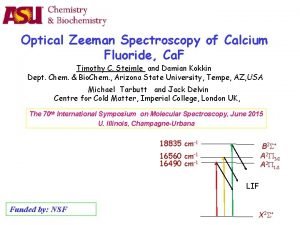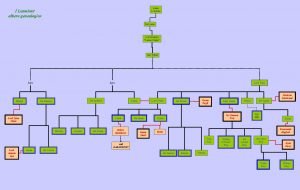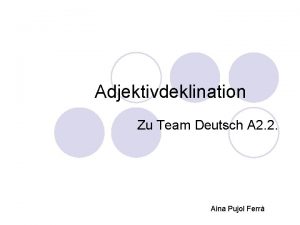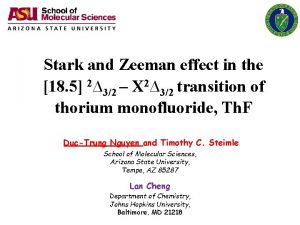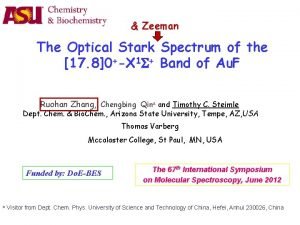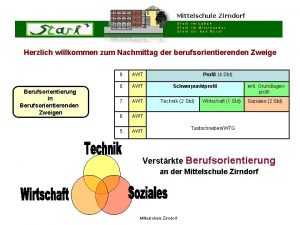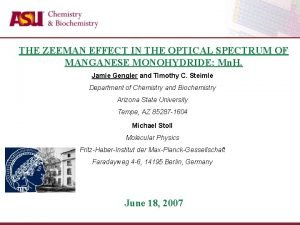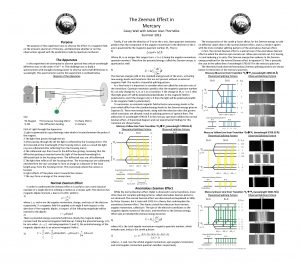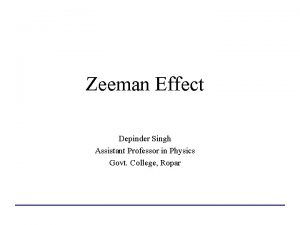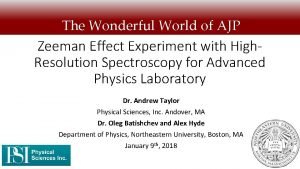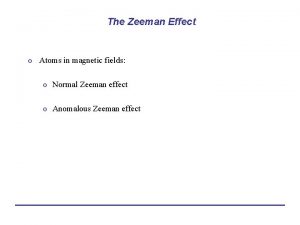STARK AND ZEEMAN EFFECT STUDY OF THE 18
![STARK AND ZEEMAN EFFECT STUDY OF THE [18. 6]3. 5 – X(1)4. 5 BAND STARK AND ZEEMAN EFFECT STUDY OF THE [18. 6]3. 5 – X(1)4. 5 BAND](https://slidetodoc.com/presentation_image_h/189b18fe3e4a7a45f83c1ecf686497b3/image-1.jpg)


![Q branch of the [18. 6]3. 5 – X(1)4. 5 transition of UF Q branch of the [18. 6]3. 5 – X(1)4. 5 transition of UF](https://slidetodoc.com/presentation_image_h/189b18fe3e4a7a45f83c1ecf686497b3/image-4.jpg)

![Stark Spectra of the P(4. 5) Line of the [18. 6]3. 5 – X(1)4. Stark Spectra of the P(4. 5) Line of the [18. 6]3. 5 – X(1)4.](https://slidetodoc.com/presentation_image_h/189b18fe3e4a7a45f83c1ecf686497b3/image-6.jpg)






![Excited [18. 6]3. 5 State (ge = 3. 26): Transition is Ω = 3. Excited [18. 6]3. 5 State (ge = 3. 26): Transition is Ω = 3.](https://slidetodoc.com/presentation_image_h/189b18fe3e4a7a45f83c1ecf686497b3/image-13.jpg)
![Molecular parameters for the X(1)4. 5 and [18. 6]3. 5 v = 0 states Molecular parameters for the X(1)4. 5 and [18. 6]3. 5 v = 0 states](https://slidetodoc.com/presentation_image_h/189b18fe3e4a7a45f83c1ecf686497b3/image-14.jpg)
![Conclusions 1. Field free spectra show perturbations in the upper state [18. 6]3. 5 Conclusions 1. Field free spectra show perturbations in the upper state [18. 6]3. 5](https://slidetodoc.com/presentation_image_h/189b18fe3e4a7a45f83c1ecf686497b3/image-15.jpg)
- Slides: 15
![STARK AND ZEEMAN EFFECT STUDY OF THE 18 63 5 X14 5 BAND STARK AND ZEEMAN EFFECT STUDY OF THE [18. 6]3. 5 – X(1)4. 5 BAND](https://slidetodoc.com/presentation_image_h/189b18fe3e4a7a45f83c1ecf686497b3/image-1.jpg)
STARK AND ZEEMAN EFFECT STUDY OF THE [18. 6]3. 5 – X(1)4. 5 BAND OF URANIUM MONOFLUORIDE, UF COLAN LINTON, ALLAN G. ADAM University of New Brunswick TIMOTHY C. STEIMLE Arizona State University Funding: Do. E (TCS) NSERC (AGA)

Previous work by Antonov and Heaven {JPC A 117, 9684 (2013)} Experiment: Analysis of pulsed laser excitation spectrum of [18. 6]3. 5 -X(1)4. 5 transition of UF Ground Ω = 4. 5 state is derived from U+(5 f 37 s 2 4 I 4. 5) F- configuration Theory: Calculations of excited state term energies in good agreement with experiment Calculated dipole moment of ground state μel = 1. 99 Debye Calculated composition of ground Ω=4. 5 state in terms of ΛS case (a) states

Present Work • High resolution (FWHM ≤ 40 MHz) experiments at ASU • 50 fold improvement in resolution over previous experiments • Rotational analysis of [18. 6]3. 5 – X(1)4. 5 0 - 0 band • Stark effect to determine dipole moments • Zeeman effect to determine configurational composition of electronic states • Use above to test theoretical predictions
![Q branch of the 18 63 5 X14 5 transition of UF Q branch of the [18. 6]3. 5 – X(1)4. 5 transition of UF](https://slidetodoc.com/presentation_image_h/189b18fe3e4a7a45f83c1ecf686497b3/image-4.jpg)
Q branch of the [18. 6]3. 5 – X(1)4. 5 transition of UF

Two extra lines for J′ ≥ 7. 5: Upper state is perturbed P(J′+1) Q(J′) R(J′-1) J′=8. 5 J′=7. 5 J′=9. 5
![Stark Spectra of the P4 5 Line of the 18 63 5 X14 Stark Spectra of the P(4. 5) Line of the [18. 6]3. 5 – X(1)4.](https://slidetodoc.com/presentation_image_h/189b18fe3e4a7a45f83c1ecf686497b3/image-6.jpg)
Stark Spectra of the P(4. 5) Line of the [18. 6]3. 5 – X(1)4. 5 transition of UF 3. 43 k. V/cm perpendicular 3. 43 k. V/cm parallel Field free

Analysis of Stark effect data Stark shift Fit Q(4. 5) and P(4. 5) Stark spectra at E = 3. 43, 3. 14, 2. 86 and 2. 57 k. V/cm with laser polarized parallel and perpendicular to electric field gave μel(X(1)4. 5) = 2. 01(1)D μel([18. 6]3. 5) = 1. 88(1) D Obs. and calc. ground state dipole moments in excellent agreement. Reduced dipole moments μel/Re = 0. 99 and 0. 92 D/Å Equivalent to nuclear charges of ~0. 20 e and 0. 19 e

Observed and Calculated Spectra of P(4. 5) Line: E = 3. 43 k. V/cm perpendicular

Zeeman Spectra of Q(4. 5 + 5. 5) Transitions Field 1. 65 k. G parallel Calc Obs 0 k. G

Analysis of Zeeman effect data Zeeman shift is given by From fit to Zeeman data in R(4. 5), Q(5. 5) at B = 1. 65 k. G with laser polarized parallel and perpendicular to magnetic field ge(X(1)4. 5) = 3. 28, ge([18. 6]3. 5)=3. 26

Interpretation of ground state g-factor (3. 28) 1. In terms of molecular 2 S+1ΛΣ States Antonov and Heaven calculated composition of ground Ω=4. 5 state 80. 74% 4Ι 4. 5 + 16. 50% 4Η 4. 5 + 2. 54% 4Γ 4. 5+ 0. 22% 4Φ 4. 5 (Λ=6, Σ=-1. 5) (Λ=5, Σ=-0. 5) (Λ=4, Σ=+0. 5) (Λ=3, Σ=+1. 5) For Hund’s case (a) states, ge = (Λ + 2. 002Σ) giving a calculated g-factor ge = 0. 8074 x 3 + 0. 1650 x 4 + 0. 0254 x 5 + 0. 0022 x 6 = 3. 22 Calculation in very good agreement with experiment

2. In terms of parent atomic states 2 S+1 LJa For a Hund’s case (c) molecular Ω state derived from atomic 2 S+1 LJa state Ground Ω=4. 5 state of UF is derived from U+ 4 I 4. 5 state L = 6, S= 1. 5, Ja = 4. 5, Ω = 4. 5 ge (calc) = 3. 27 ge (exp) = 3. 28 Molecular ground state derived entirely from U+ (f 3 s 2) 4 I 4. 5 state
![Excited 18 63 5 State ge 3 26 Transition is Ω 3 Excited [18. 6]3. 5 State (ge = 3. 26): Transition is Ω = 3.](https://slidetodoc.com/presentation_image_h/189b18fe3e4a7a45f83c1ecf686497b3/image-13.jpg)
Excited [18. 6]3. 5 State (ge = 3. 26): Transition is Ω = 3. 5 – 4. 5. Logical choice for ΔΩ = -1 transition to predominantly 4Ι 4. 5 state is 4Η 3. 5 For 4Η 3. 5 ge = 5 + 2. 002 x -1. 5 = 2 Other possibilities giving an Ω = 3. 5 state 4Γ 4Φ 4Δ (g = 3): (g = 4): 3. 5 e 3. 5 (ge = 5) Excited Ω = 3. 5 state is possibly a mixture of predominantly 4Γ 3. 5 and 4Φ 3. 5 with possibly small contributiions from 4Η 3. 5, 4Δ 3. 5 and other states
![Molecular parameters for the X14 5 and 18 63 5 v 0 states Molecular parameters for the X(1)4. 5 and [18. 6]3. 5 v = 0 states](https://slidetodoc.com/presentation_image_h/189b18fe3e4a7a45f83c1ecf686497b3/image-14.jpg)
Molecular parameters for the X(1)4. 5 and [18. 6]3. 5 v = 0 states of UF State Parameter X(1)4. 5 [18. 6]3. 5 T 0 (cm-1) 0 18624. 5349(15)a B 0 (cm-1) 0. 23247(3) 0. 22754(3)a μel (Debye) 2. 01(1) 1. 88(1) ge 3. 28(1) 3. 26(1) a From fit to lowest 4 levels
![Conclusions 1 Field free spectra show perturbations in the upper state 18 63 5 Conclusions 1. Field free spectra show perturbations in the upper state [18. 6]3. 5](https://slidetodoc.com/presentation_image_h/189b18fe3e4a7a45f83c1ecf686497b3/image-15.jpg)
Conclusions 1. Field free spectra show perturbations in the upper state [18. 6]3. 5 2. Stark effect shows ground state dipole moment of 2. 01 D in excellent agreement with Antonov and Heaven calculation. Nuclear charge ~0. 2 e 3. Zeeman effect shows that (i) the calculated compostion of the X(1)4. 5 ground state in terms of Hund’s case (a) ΛS states reproduces the observed electronic g-factor very well. (ii) The ground state arises almost entirely from the U+(5 f 76 s 2 4 I 4. 5) Fconfiguration 4. The discussion on the upper state configuration is highly speculative. The g-factor suggests possible configurations and eliminates others. 5. More theoretical calculations are needed
 Stark and zeeman effect
Stark and zeeman effect Anomalous zeeman effect
Anomalous zeeman effect Efeito de zeeman
Efeito de zeeman Atom va yadro fizikasi
Atom va yadro fizikasi Zeeman
Zeeman Zeeman splitting
Zeeman splitting Zeeman
Zeeman Zeeman effektus
Zeeman effektus Stark metropolitan housing
Stark metropolitan housing Stark law exceptions
Stark law exceptions Albero genealogico stark
Albero genealogico stark Stark law exceptions
Stark law exceptions Grothus draper law diagram
Grothus draper law diagram Centar za odgoj i obrazovanje ivan štark
Centar za odgoj i obrazovanje ivan štark Bilder
Bilder Josua 1 9 sei mutig und stark
Josua 1 9 sei mutig und stark
